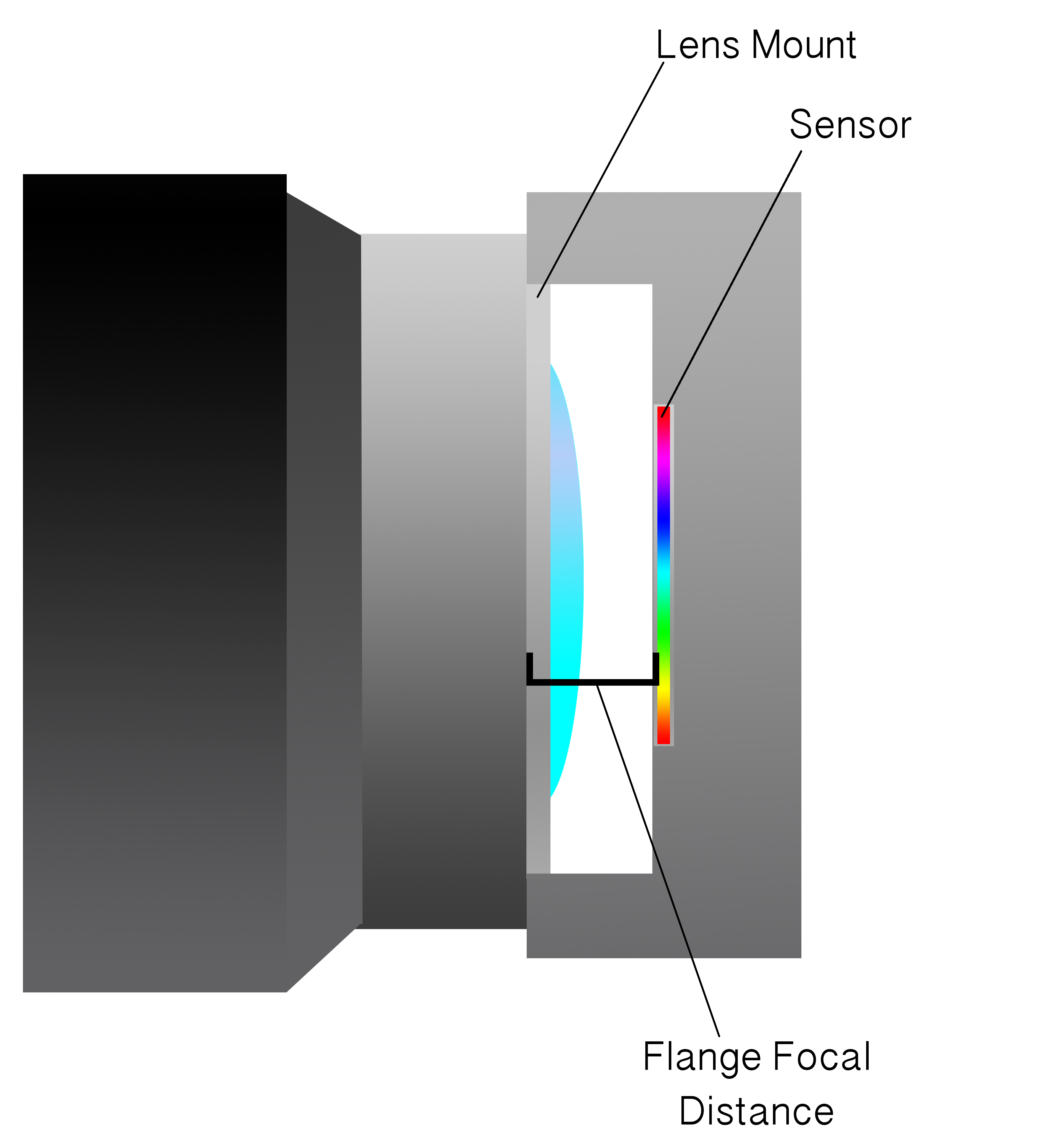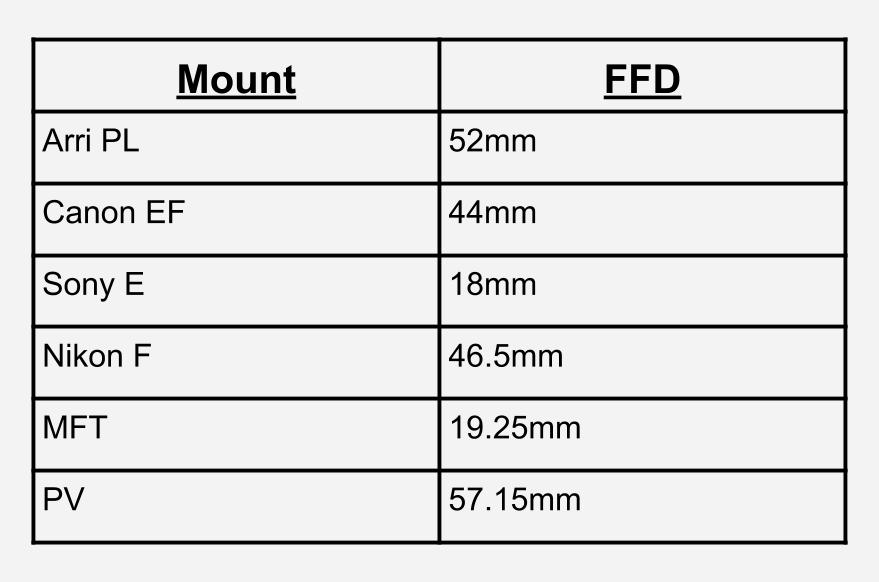Occasionally, we will have some maverick young filmmaker walk through our doors, proudly brandishing a really cool vintage SLR lens, hoping and/or assuming we have the means to let them put it on one of our higher-end cinema cameras. That person’s friend occasionally follows, requesting to rent a set of purpose-built cinema lenses in PL mount to slap onto their 5D. Unfortunately, part of our job is delivering the bad news that neither of these people can (or should) be doing the thing they are trying to do. But don’t feel too bad! There are options when the lens you want to use doesn’t match the camera body you want to use. It can get tricky to keep track of and understand what is and is not possible in the world of lens mount compatibility, but hopefully, after this article, you’ll feel confident in making an informed decision.
Common Lens Mounts
There are dozens of lens mounts for all different sorts of cameras. We’ll be focusing on the 3 mounts we encounter most regularly. Those mounts are PL, EF, and E. (We’ll give an honorable mention to Nikon F, Micro Four Thirds and Panavision’s PV-Mount, but it’s rare we run into those).
Arri PL Mount
Arri’s PL-mount is rock-solid and is the cinema industry standard. It has a locating pin for orientation and a rotating breech lock ring that serves as its locking mechanism. It is made to be heavy-duty, precise, and dependable. (PL stands for Positive Lock, by the way). PL-Mount lenses are also among the most expensive lenses available and are significantly harder to find in the “prosumer” market. Most PL-Mount lenses throughout history have been designed to cover a super-35 size film plane or sensor, but there is a recent increase in PL lenses with image circles that cover Full Frame. It is heavier and larger than most other lens mounts.
Canon EF Mount
Canon’s EF Mount is possibly the most commonplace mount you see because it spans the stills and cinema/video worlds. This means lots of available lenses ranging from low to high quality and cost. EF stands for “Electro-Focus” but there are auto and manual-focus EF lenses available. The EF mount is a bayonet-style button lock and release that clicks when properly rotated into the correct location. Most EF lenses designed for still photography will indeed cover a Full Frame sensor, although there are other options such as APS-C and Super 35. It is sturdy, but not quite as beefy as the aforementioned PL.
Sony E-Mount
Sony’s E-Mount operates essentially like the EF mount, with a bayonet, rotate-and-click locking mechanism. It has a very short flange focal depth (distance between lens mount and sensor, henceforth referred to as “FFD”) which makes camera bodies with this mount easily adaptable to accept other lenses. Many E-Mount lenses cover full frame. The downsides are that there are fewer high quality, recognized E-Mount lenses available (although Sony is trying to change that) and the standard E mount is slightly flimsier than others. Sony does offer a more secure locking E-Mount on some of its newer cameras, though.
Micro Four Thirds
Micro Four Thirds mount was originally developed for mirrorless cameras with a Four Thirds sensor. As such, like the E-Mount, it is easily adaptable because of its very short FFD. Most cameras with this mount have small sensors (the Four Thirds sensor is about 30% smaller than APS-C and Super 35), and most lenses designed with this mount won’t cover larger sensors.
Panavision PV Mount
Panavision’s breech lock mount is very similar to Arri PL. It is sturdy and secure and is the other film industry standard. Unfortunately, it is proprietary to Panavision, and only available for Panavision cameras and lenses, or those that have been “Panavised”.
OK, got it. Now how do I make this work?
The ability to put a lens and camera with different mounts together depends mostly on the flange focal distance of the mounts. The flange focal distance refers to the distance between the point where the lens and camera mounts make contact and the sensor. Nothing happens in this distance except giving the lens space to focus onto the sensor. Every different lens has a specific backfocus distance, which is the distance between the rear element of the lens and the point at which it focuses. The mount of the lens is designed to accommodate this distance.
Here is a quick guide for keeping track of the flange focal distances some of the more common mounts.


Modification vs Adapting vs Interchangeable Mounts
There is an almost endless number of lens mounts for cinema and photography, as well as for the scientific/industrial sector. Ultimately the decision of whether or not to try to use a lens on a mount it is not native to will have to be made on a case by case basis. But here’s some basic information to get you started.
Adapting a lens to a mount usually refers to adding a piece of hardware with the camera mount on one side and the lens mount on the other. Modification, on the other hand, entails permanently changing the mount of a lens. This requires a good bit of engineering and is almost always done by a lens technician.
In order for an adapter or modification to be effective, it needs to maintain the backfocus of that particular lens. So if an adapter changes the distance between the rear element and the sensor from what it is designed to be, problems such as inaccurate focus scales and inability to reach infinity focus arise. So don’t try to DIY a lens modification unless you have an optical bench, some engineering chops, a machine shop, and a hefty bankroll.
Some lens manufacturers are making end-user-swappable mounts, which is kind of a middle area between an adapter and a modification. Outside of adapters and lens modifications, many cameras have also some sort of interchangeable mount system, and often rental houses can swap that for you before the shoot. This is always preferred to using an adapter.
Choosing an Adapter
When selecting an adapter, choose a trusted brand – even though it might hit your wallet a little bit harder. There are a lot of cheap adapters out there that, sure, will allow you to mount a lens to a camera with a different mount, but will neglect to mention in the advertising copy that you won’t be able to reach infinity focus, or that the adapter will become permanently stuck on to your lens.
The rule of thumb for adapting lens mounts is that adapting is possible if the flange focal depth of the camera-side lens mount is shorter than that of the lens-side lens mount, with enough space in between to accommodate the distance between the rear element of the lens and the sensor that is necessary and accurate for correct backfocus. Matthew Duclos of Duclos Lenses writes about it here with helpful illustrations that explain the technical trials and tribulations of lens mount compatibility further.
There are other things to consider besides physical mount compatibility with adapters. On lenses with electronics, if you want the lens data to pass through the adapter, you’ll have to make sure the adapter you choose has the appropriate electronic contacts. Also, consider the optical design and sensor size. If you want to use glass designed for a Super 35 sensor on a Micro Four Thirds camera, you should consider a focal reducer, such as the Metabones Speedbooster. This will reduce the size of the image on the sensor and give you an extra stop of light as a bonus. There’s also the inverse, such as an expander, which can allow you to, for example, put a lens designed for Super 35 on a full frame camera. These expanders sometimes also allow for adapting mounts.
To sum up, here are some conversations we’ve had (so you don’t have to)
Q: Can I have an adapter to put this PL Lens on my EF Camera?
A: Not from us, because the rear element will almost definitely smash into the sensor. You can buy a cheap adapter from Amazon that claims to let you do this, but it will only work with a very limited number of lenses and you’ll probably break everything.
Q: Can I have an adapter to put this EF Lens on my PL camera?
A: No, because you can’t get the rear element close enough to the sensor to properly focus to infinity or have accurate focus marks.
Q: Can I have an adapter to put this PL Mount Lens on my E-Mount Camera?
A: Sure! The flange focal distance of E-Mount is short enough that an adapter has enough space to keep the rear element of the PL lens the correct distance away from the sensor. Metabones makes a couple great products that will allow you to do this safely and accurately. You can do this with almost any other lens mount, including EF!
Q: Can I have an adapter to put this EF-Mount lens on my E-Mount Camera?
A: Remember when I just told you that you could? You still can!